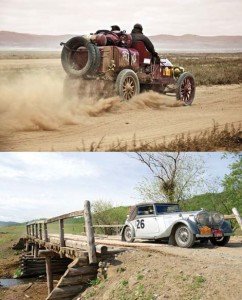 “The Peking to Paris was the first international event for cars and ran in 1907, and was like men landing on the moon – it was a staggering achievement to get a car half way around the world. They had no maps, there were no roads for much of the route, they had no use for money, they shaved bits off silver lumps to barter, there were no petrol stations, cars then used up tyres at a horrendous rate yet the winner, who won by a week, still drove from Paris to his home in Rome on one of the tyres he had set out on (a Pirelli). They cheated on each other all the way. “
“The Peking to Paris was the first international event for cars and ran in 1907, and was like men landing on the moon – it was a staggering achievement to get a car half way around the world. They had no maps, there were no roads for much of the route, they had no use for money, they shaved bits off silver lumps to barter, there were no petrol stations, cars then used up tyres at a horrendous rate yet the winner, who won by a week, still drove from Paris to his home in Rome on one of the tyres he had set out on (a Pirelli). They cheated on each other all the way. “
Billed as the greatest motoring adventure, the fifth Peking to Paris Rally which started from China’s capital on 28th May successfully completed on 29th June. Organised by the Endurance Rally Organisation (ERA), more than 100 cars from various eras and manufacturers, representing 26 countries, travelled half way round the world in just 33 days before arriving in Paris.
Since the early pioneers first drove from Peking to Paris in 1907, the ERA has organised the rally along the lines of the original pioneering event. Crews will drive the original route of Prince Borghese, the 1907 winner, over the vast wilderness of northern Mongolia, where there are often no roads or tracks at all, relying on their own wits and navigation ability, camping besides rivers and lakes for 10 nights.
It’s the longest and toughest rally a classic car can compete in, crossing mountains and deserts and fording wide and fast-flowing rivers.
Back in 1907 just five cars took part. Now the Peking to Paris receives entries from around the world. The oldest car taking part is a 1913 Ford Model T, while a 1917 LaFrance has the biggest engine at a whopping 14.5-litres. The smallest-engined car is a 1250cc MG TD, narrowly taking the accolade from the youngest car entered, a 1300cc 1982 Renault 4.
From China the route passes through Mongolia, the world’s most sparsely populated independent country, with the Gobi Desert once again being a rally highlight. From Mongolia the route travels through Russia, avoiding main roads and major towns and cities, and the longest stage sees competitors travelling 668Km (415 miles) in one day, as they journey from Novosibirsk to Omsk.
With such a grueling route, much of which is on unmade surfaces, pre-war cars with their greater ground clearance should perform well. In the pre-1942 classes covering 1920-1931 and 1932-1941 Bentleys remain very popular, with eight entered, and three Rolls-Royces join them. American cars are also a popular choice and in the pre-1942 classes 19 are competing.
Some competitors have opted for rear-engined cars. The field is made up of three Porsche 991, two Porsche 356s, a VW Beetle and a rare 1958 Renault Fregate.
With such a selection of cars and such a long, tough route, there’s all to play for – more than 7,500 miles in a classic car is sure to be a challenge for crew and car…
The international interest in the event is not only with the entrants, who hail from Australia, Canada, Japan, New Zealand and all over Europe as well as including a strong British contingent, but with the media too.
The event was filmed by a documentary television team from CBS News while BBC TV from their World Service newsdesk covered the start at the Great Wall in China and the finish in Place Vendome, Paris. BBC World TV is represented in the event aboard the 1938 Ford Coupe of Mike Reeves and travel writer Michelle Jana Chan.
For more information on the Peking to Paris Rally or any future Endurance Rally Association event – call +44 (0) 1235 831221
visit www.endurorally.com